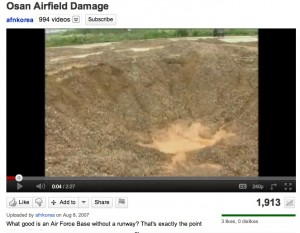08/11/2011 by Ed Timperlake
The F-35B will give the United States Marine Corps the ability to advance against any enemy from the sea with air cover moving ashore in support of Marine ground combat forces.
This agility and flexibility in selecting the initial objective to seize and move out is rooted in “air field agility.” The ability of the F-35B and associated Amphibious Ready Group assets to operate from any 3000 feet hard straight surface shapes a new strategic tool set.
What makes this possible is the F-35B has both a fully up air-to-air and air-to-ground capability. In the AA mode it is supersonic and stealthy with the same “Z-axis” revolutionary C4ISR-D cockpit that Navy F-35Cs and AF –F-35As both have. Consequently, the F-35B can fit seamlessly into the Air Force/Navy Air Dominance mission.
The F-35 is not a linear performance enhancement from F/A-18 4th Gen; it has a third performance axis “Z” The “Z” axis is the pilot’s cockpit C4ISR-D “OODA” loop axis. The memo does not address this revolutionary point. Traditionally, the two dimensional depiction is that the x-axis is time and the y-axis is performance and captures the evolution of individual airplanes that tend to cluster in generation improvement. Each aircraft clustered in a “generation” is a combination of improvements. Essentially, the aeronautical design “art” of blending together ever improving and evolving technology eventually creates improvements in a linear fashion.
The design characteristics blended together prior to F-35 have been constantly improving range, payload (improved by system/and weapons carried), maneuverability (measured by P Sub s), useful speed, and range (modified by VSTOL–a plus factor). The F-35 is also designed with inherent survivability factors-first redundancy and hardening and then stealth. Stealth is usually seen as the 5th Gen improvement. But reducing the F-35 to a linear x-y axis improvement or to stealth simply misses the point. The F-35 is now going to take technology into a revolutionary three-dimensional situational awareness capability. This capability establishes a new vector for TacAir aircraft design. This can be measured on a “Z” axis.
Historically, C3I was external to 1,2,3, and 4th Generations TacAir. C3I’s goal was enhancing fleet wide combat performance for all Type/Model/Series (T/M/S) of TacAir. This is the modern AWACS battle concept. Now using a three-dimensional graph the “Z-axis” takes airpower into a totally different domain.The shift is from externally provided C3I to C4ISR-D in the cockpit carried by the individual air platform. This is the revolutionary step function that breaks the linear progression of previous Generations. The “Z” axis in which the F-35 is the prototype for the first “C4ISR –D (for decision) cockpit”But wait it gets even better the entire F-35 Type/Model/Series connects the Air Force, Navy, Marines, and Allies in a cohesive unified fighting force. One additional assets that can really augment this US and Allied “joint” air force and that is the Aegis Ships with the SM-3 missile.

http://www.youtube.com/watch?v=i9DJVhl1Q1M
No longer should the F-35B be considered a boutique niche aircraft only essential for Marine combat con-ops. With vision and commitment on numbers it can become a tactical aircraft that sends a strategic signal.
The reason is simple, an F-35B can stand strip alert on any long runway, US or Allied. From a strategic point of view think of Guam, South Korea or in the Middle East on all long runways. As a crisis situation develops, the F-35Bs can be remotely placed in secret hardened bunkers and revetments and thus become a significant deterrence asset that can instantly sortie into combat and return to gas and go again and again.
(https://sldinfo.com/the-f-35b-has-a-unique-war-winning-capability/)
By using a detachment of F-35Bs the issue of enemy runway area denial and need for rapid runway repair does not become a show stopper to ops-tempo both offensively and defensively.
 Tie an F-35B to the Aegis and the entire “wasting argument” about asymmetric IRBM and enemy strike against our hard fixed land targets becomes moot. This is because Guam for example will still have air power in its defense. This principal can be applied globally.
Tie an F-35B to the Aegis and the entire “wasting argument” about asymmetric IRBM and enemy strike against our hard fixed land targets becomes moot. This is because Guam for example will still have air power in its defense. This principal can be applied globally.
Unfortunately, there was no way to express this in Under Secretary Work’s memo. It would be important to highlight the discriminator among the aircraft in terms of ability to connect with adjacent weapons platforms be a basic operating assumption.
Clearly, he could not suggest the Air Force and Allies buy the F-35B. But he can sure insist and guarantee the USMC only buys F-35B and that would be a very good thing to do. And this will then open the gates to the possibility of allies beyond Spain and Italy buying F-35Bs, and would highlight that the F-35C is the boutique aircraft, because tied to carrier air decks, whereas the F-35B is a flexible tool able to deploy on many ships and on many airfields, fixed, long, short, or not even today operational airfields. The F-35B reverses the relationship between pre-defined operational bases and the aircraft. The aircraft no longer constrains the definition of an airfield.
As far as USAF and Allies a few Squadrons of F-35Bs could be an invaluable insurance asset to stay in the battle if runways are sucker punched by the crazy follow on to the “Dear Leader” in North Korea, or Iranian fanatics with IRBMs. Taiwan could also send a powerful signal to the PLAAF if we allowed them to purchase the F-35B.
The 21st Century US Military has the potential to be the most agile combat force in the world by leveraging the F-35B throughout the force, rather than considering this solely a USMC weapon system.


